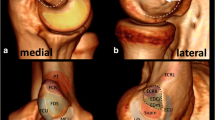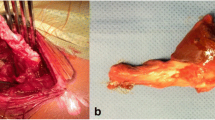Abstract
ᅟ
The aim of this study was to demonstrate that ultrasound can allow a precise assessment of the indirect tendon of the rectus femoris using a new lateral approach.
Methods and materials
Four hips were dissected for the anatomical study of the proximal rectus femoris insertions. Under ultrasonographic guidance, spinal needles piercing the direct tendon were placed in the indirect tendon, following by dissection. Then, high-resolution ultrasound was performed in 20 volunteers with assessment of the indirect tendon of the rectus femoris.
Results
At dissection, the spinal needles were located in or immediately adjacent to the indirect tendon, thus confirming that it was correctly depicted by ultrasound. The indirect tendon could be identified in each cadaver and each volunteer with ultrasound. The optimal position of the probe to allow assessment of the indirect tendon could be defined. No significant changes in the appearance or thickness of the tendon could be observed.
Conclusion
The results of our study showed that the indirect tendon of the rectus femoris muscle can be clearly depicted by sonography in healthy adult subjects. The potential applications of this new use of sonography must now be confirmed by clinical studies.
Key Points
• The anatomy of the proximal rectus femoris is reviewed
• Until now, sonography was limited for assessing direct and conjoined tendons
• The indirect tendon can be clearly depicted by sonography
• A new lateral approach for studying the indirect tendon is described







Similar content being viewed by others
References
Hasselman CT, Best TM, Hughes C, Martinez S, Garrett WE Jr (1995) An explanation for various rectus femoris strain injuries using previously undescribed muscle architecture. Am J Sports Med 23:493–499
Hapa O, Bedi A, Gursan O et al (2013) Anatomic footprint of the direct head of the rectus femoris origin: cadaveric study and clinical series of hips after arthroscopic anterior inferior iliac spine/subspine decompression. Arthroscopy 29:1932–1940
Ryan JM, Harris JD, Graham WC, Virk SS, Ellis TJ (2014) Origin of the direct and reflected head of the rectus femoris: an anatomic study. Arthroscopy 30:796–802
Grassé P (1971) Traité de zoologie, 1971st edn. Masson et Cie, Paris
Paturet P (1951) Traité d'anatomie humaine. Masson et Cie, Paris
Tubbs RS, Stetler W Jr, Savage AJ et al (2006) Does a third head of the rectus femoris muscle exist? Folia Morphol (Warsz) 65:377–380
Nene A, Mayagoitia R, Veltink P (1999) Assessment of rectus femoris function during initial swing phase. Gait Posture 9:1–9
Nene A, Byrne C, Hermens H (2004) Is rectus femoris really a part of quadriceps? Assessment of rectus femoris function during gait in able-bodied adults. Gait Posture 20:1–13
Orchard J, Seward H (2002) Epidemiology of injuries in the Australian Football League, seasons 1997-2000. Br J Sports Med 36:39–44
Rask MR, Lattig GJ (1972) Traumatic fibrosis of the rectus femoris muscle. Report of five cases and treatment. JAMA 221:268–269
Hughes C, Hasselman CT, Best TM, Martinez S, Garrett WE Jr (1995) Incomplete, intrasubstance strain injuries of the rectus femoris muscle. Am J Sports Med 23:500–506
Bianchi S, Martinoli C, Waser NP, Bianchi-Zamorani MP, Federici E, Fasel J (2002) Central aponeurosis tears of the rectus femoris: sonographic findings. Skelet Radiol 31:581–586
Cross TM, Gibbs N, Houang MT, Cameron M (2004) Acute quadriceps muscle strains: magnetic resonance imaging features and prognosis. Am J Sports Med 32:710–719
Bordalo-Rodrigues M, Rosenberg ZS (2005) MR imaging of the proximal rectus femoris musculotendinous unit. Magn Reson Imaging Clin N Am 13:717–725
Gyftopoulos S, Rosenberg ZS, Schweitzer ME, Bordalo-Rodrigues M (2008) Normal anatomy and strains of the deep musculotendinous junction of the proximal rectus femoris: MRI features. AJR Am J Roentgenol 190:W182–W186
Wittstein J, Klein S, Garrett WE (2011) Chronic tears of the reflected head of the rectus femoris: results of operative treatment. Am J Sports Med 39:1942–1947
Ouellette H, Thomas BJ, Nelson E, Torriani M (2006) MR imaging of rectus femoris origin injuries. Skelet Radiol 35:665–672
Kassarjian A, Rodrigo RM, Santisteban JM (2012) Current concepts in MRI of rectus femoris musculotendinous (myotendinous) and myofascial injuries in elite athletes. Eur J Radiol 81:3763–3771
Hosalkar HS, Pennock AT, Zaps D, Schmitz MR, Bomar JD, Bittersohl B (2012) The hip antero-superior labral tear with avulsion of rectus femoris (HALTAR) lesion: does the SLAP equivalent in the hip exist? Hip Int 22:391–396
Foote CJ, Maizlin ZV, Shrouder J, Grant MM, Bedi A, Ayeni OR (2013) The association between avulsions of the reflected head of the rectus femoris and labral tears: a retrospective study. J Pediatr Orthop 33:227–231
Nanka O, Havranek P, Pesl T, Dutka J (2003) Avulsion fracture of the pelvis: separation of the secondary ossification center in the superior margin of the acetabulum. Clin Anat 16:458–460
Sarkar JS, Haddad FS, Crean SV, Brooks P (1996) Acute calcific tendinitis of the rectus femoris. J Bone Joint Surg (Br) 78:814–816
Flemming DJ, Murphey MD, Shekitka KM, Temple HT, Jelinek JJ, Kransdorf MJ (2003) Osseous involvement in calcific tendinitis: a retrospective review of 50 cases. AJR Am J Roentgenol 181:965–972
Kim YS, Lee HM, Kim JP (2013) Acute calcific tendinitis of the rectus femoris associated with intraosseous involvement: a case report with serial CT and MRI findings. Eur J Orthop Surg Traumatol 23:S233–S239
Peetrons P (2006) Atlas d'échographie du système locomoteur Sauramps Médical Montpellier
Bianchi S, Martinoli C (2007) Ultrasound of the musculo-skeletal system. Springer, Heidelberg
European Society of Musculoskeletal Radiology (2010) Musculoskeletal ultrasound technical guidelines. IV Hip. European Society of Skeletal Radiology (Vienna). Available via http://www.essr.org/html/img/pool/hip.pdf
Acknowledgments
The scientific guarantor of this publication is Pr. A. Cotten. The authors of this manuscript declare no relationships with any companies, whose products or services may be related to the subject matter of the article. The authors state that this work has not received any funding. No complex statistical methods were necessary for this paper. Institutional Review Board approval was obtained. Written informed consent was obtained from all subjects (volunteers) in this study. No study subjects or cohorts have been previously reported. Methodology: prospective study.
Author information
Authors and Affiliations
Corresponding author
Rights and permissions
About this article
Cite this article
Moraux, A., Wawer, R., Lefevbre, G. et al. An anatomical study of the indirect tendon of the rectus femoris using ultrasonography. Eur Radiol 25, 3614–3619 (2015). https://doi.org/10.1007/s00330-015-3769-1
Received:
Revised:
Accepted:
Published:
Issue Date:
DOI: https://doi.org/10.1007/s00330-015-3769-1




